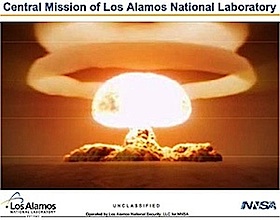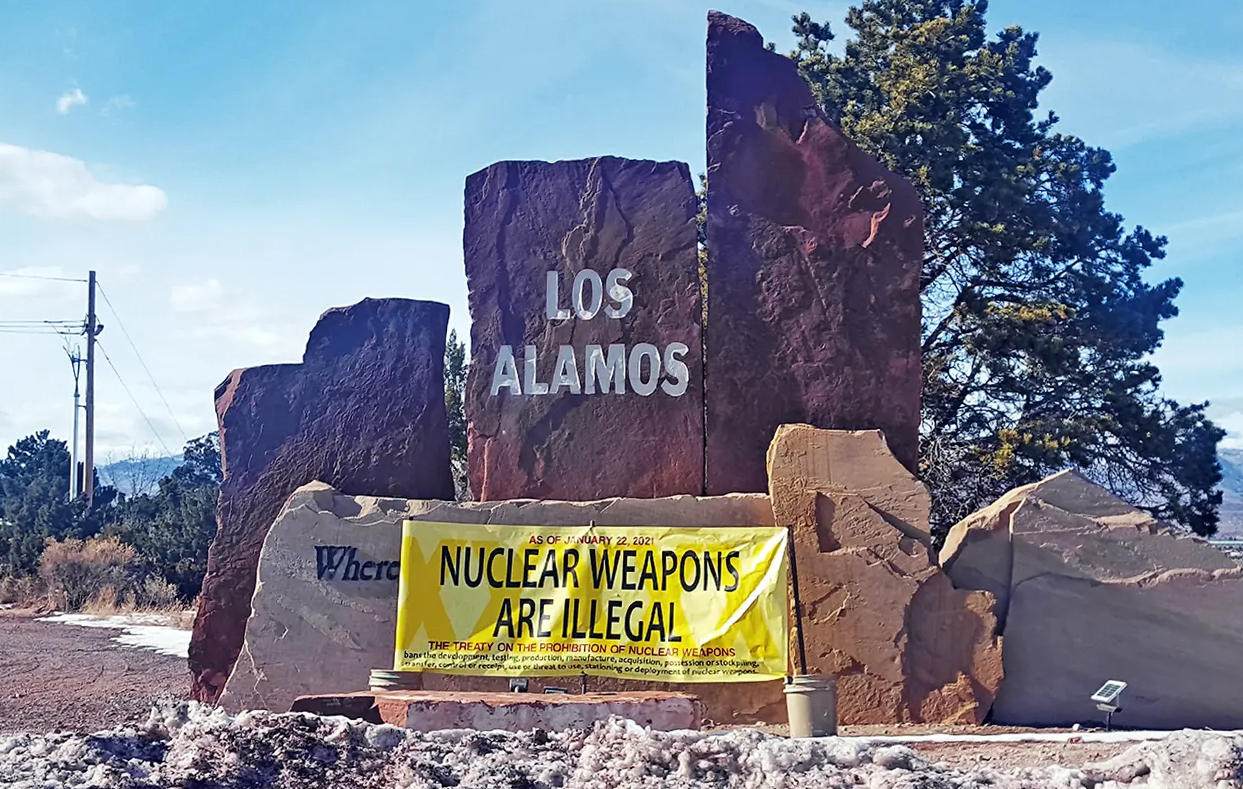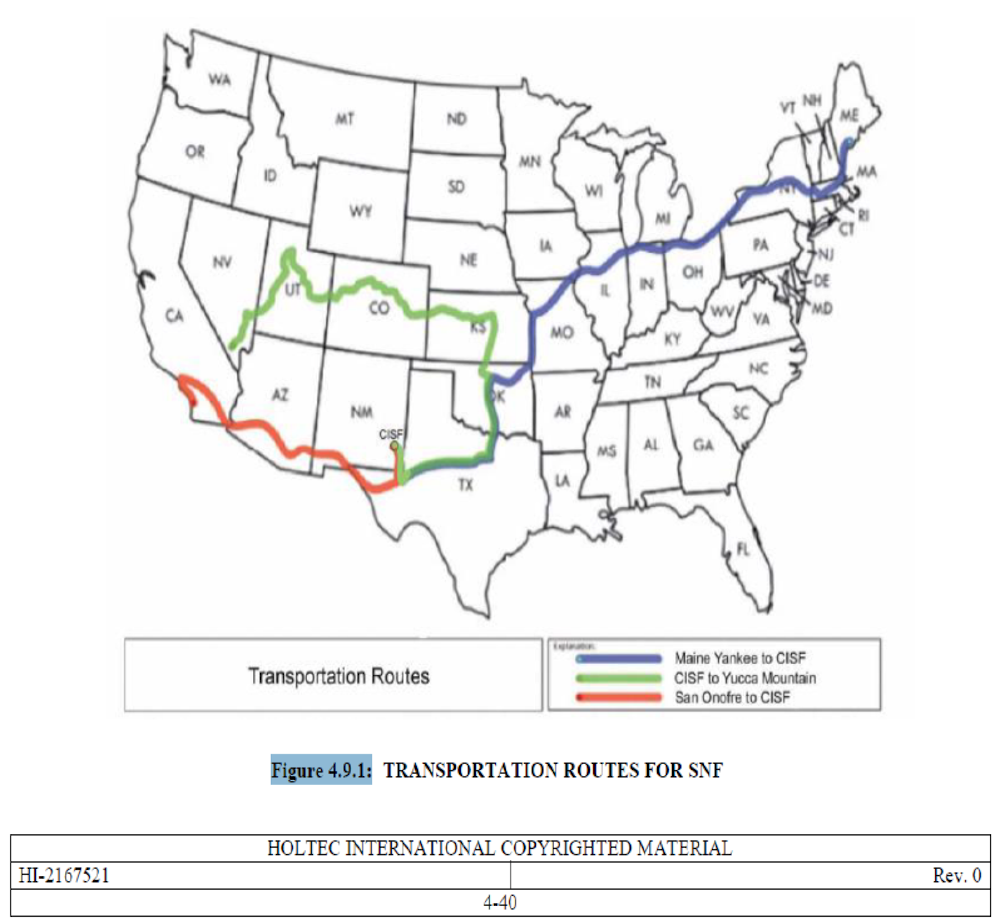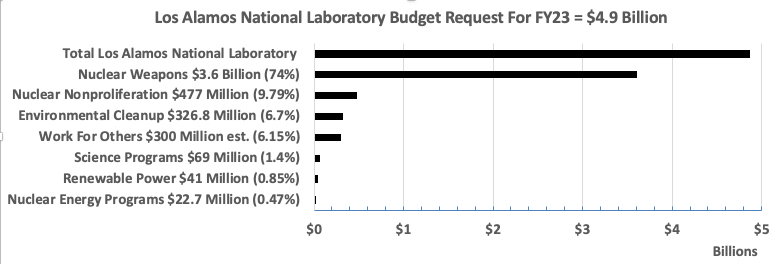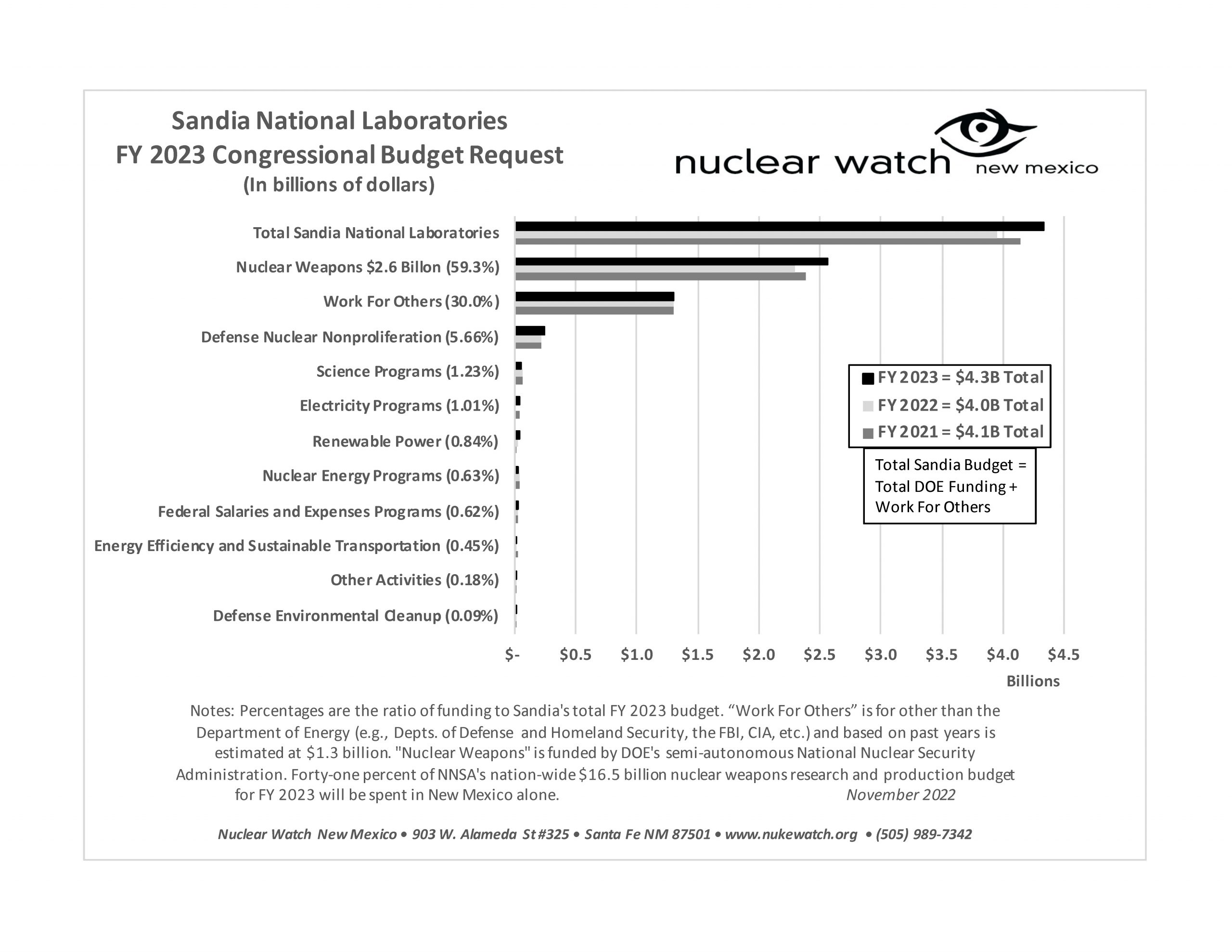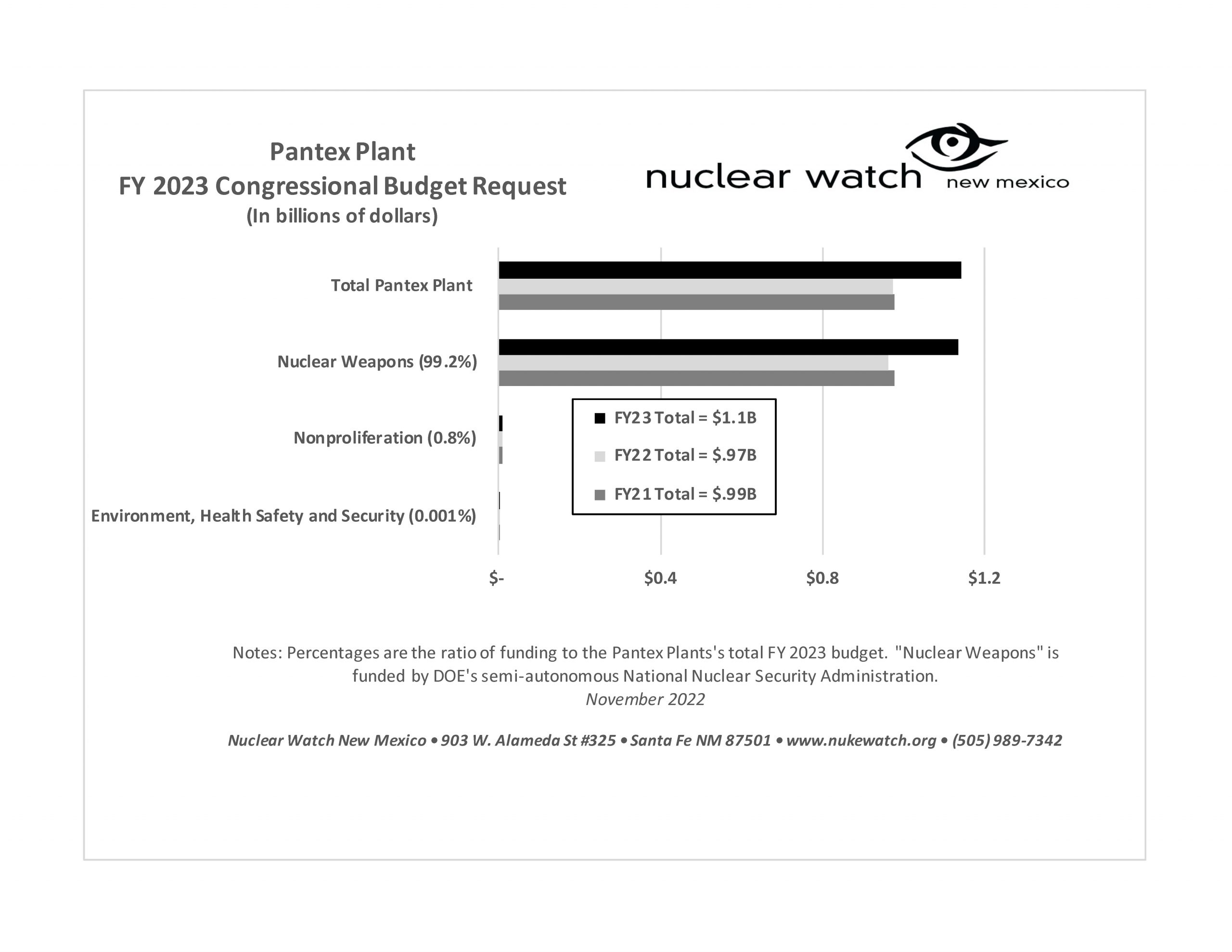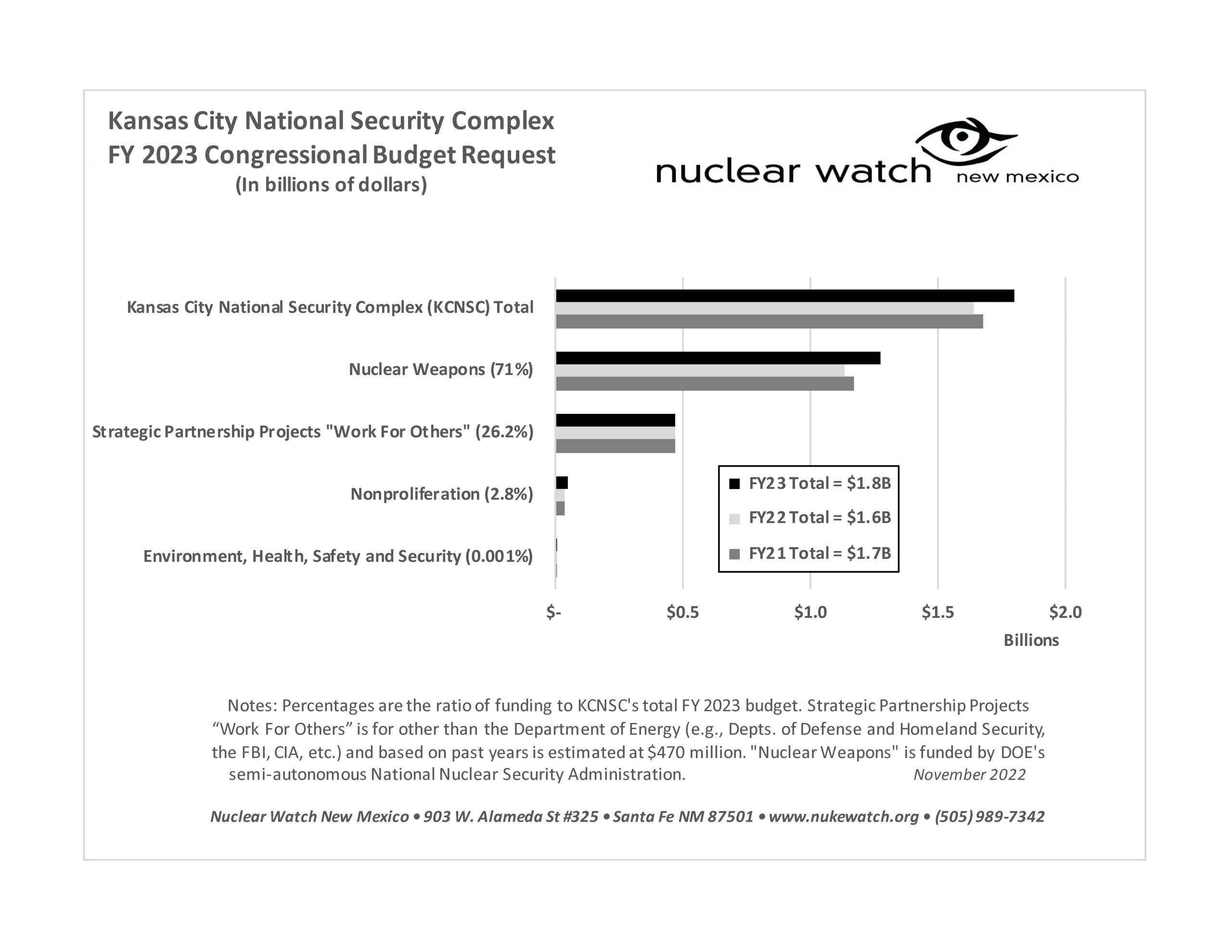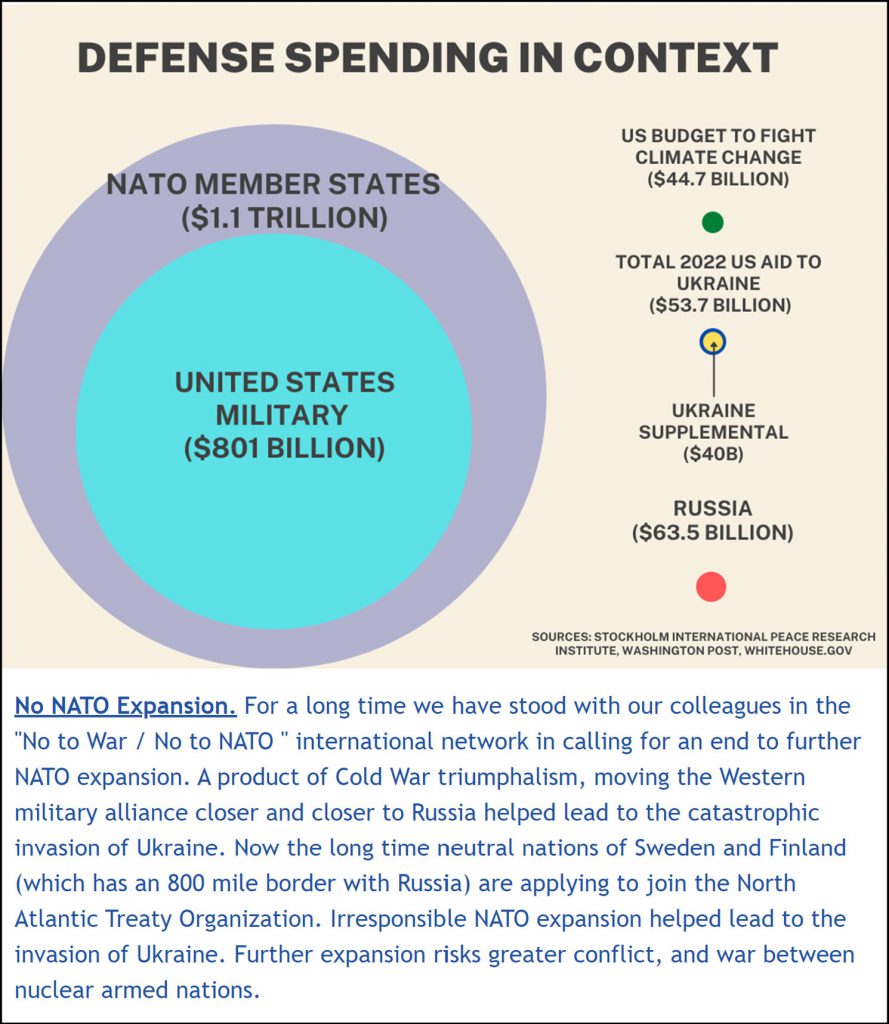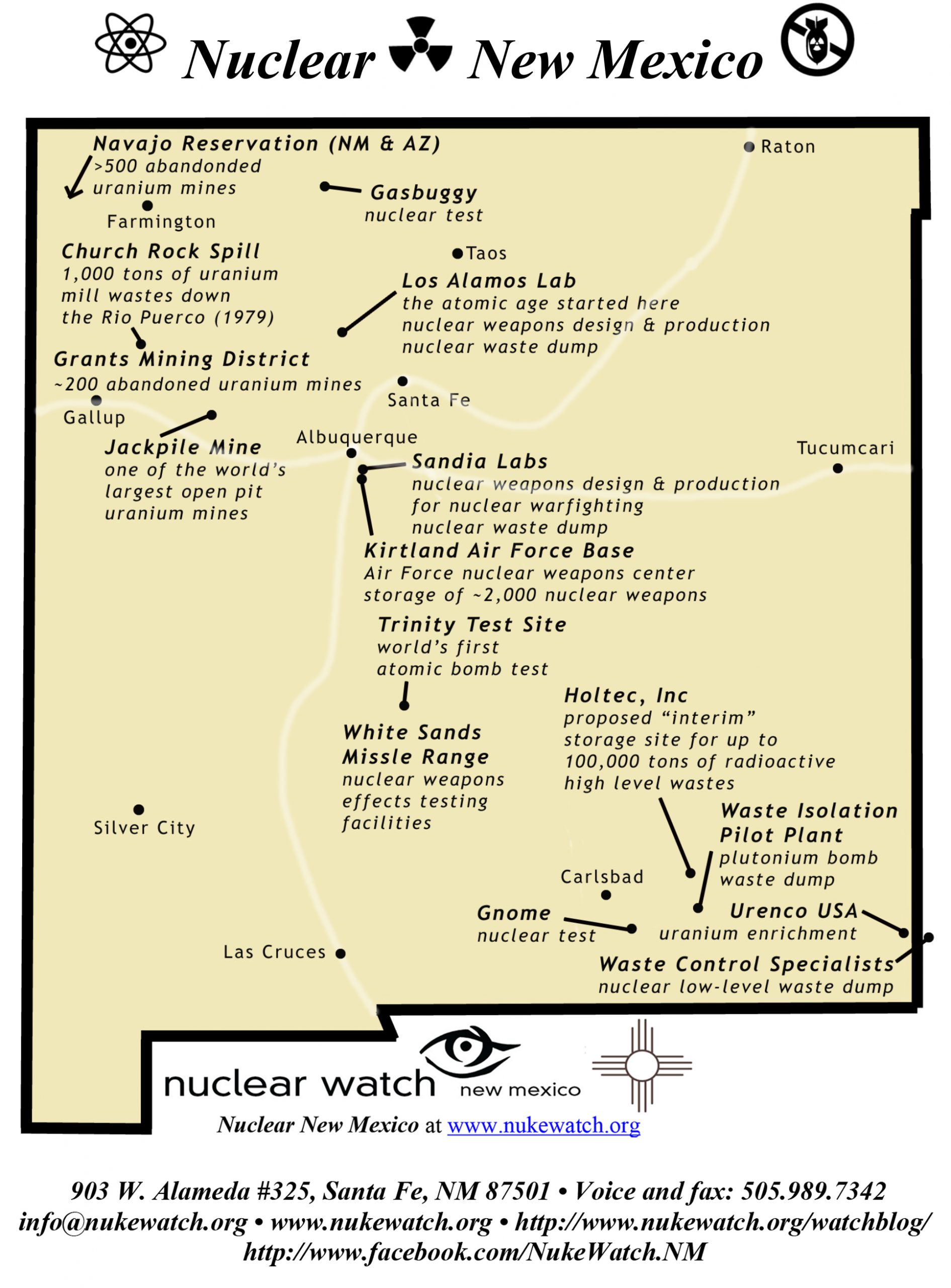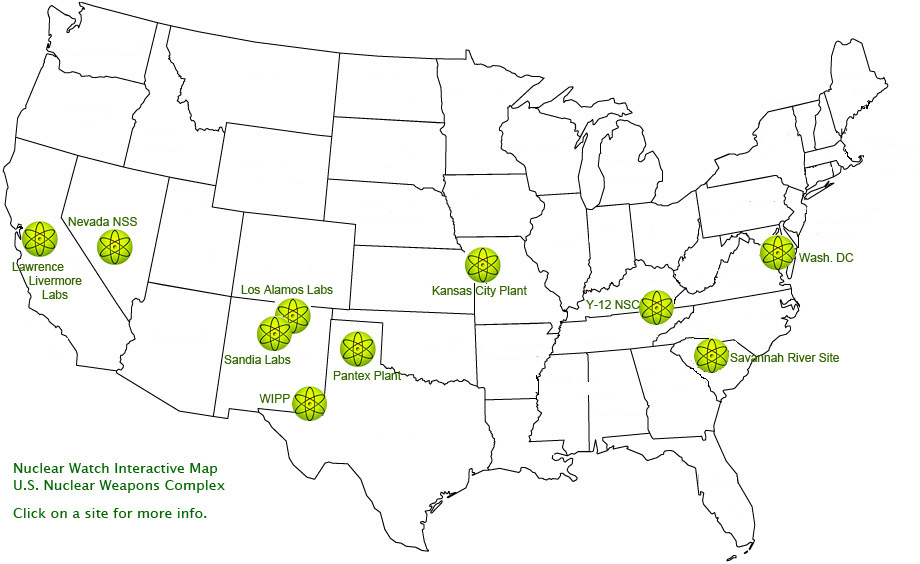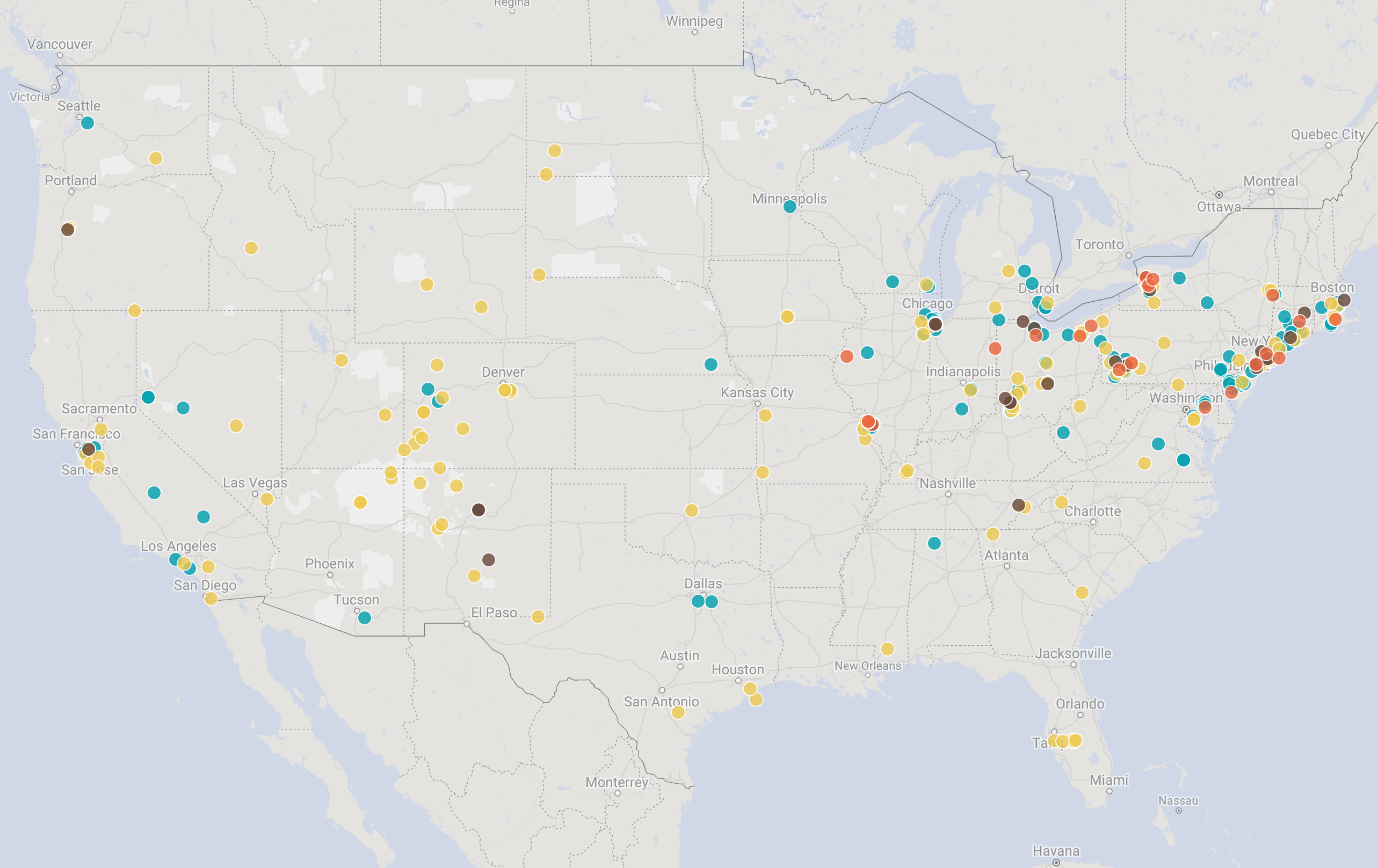QUOTE OF THE WEEK
Nothing Found
It seems we can’t find what you’re looking for. Perhaps searching can help.
LANL’s Central Mission: Los Alamos Lab officials have recently claimed that LANL has moved away from primarily nuclear weapons to “national security”, but what truly remains as the Labs central mission? Here’s the answer from one of its own documents:
LANL’s “Central Mission”- Presented at: RPI Nuclear Data 2011 Symposium for Criticality Safety and Reactor Applications (PDF) 4/27/11
Banner displaying “Nuclear Weapons Are Now Illegal” at the entrance in front of the Los Alamos National Lab to celebrate the Entry Into Force of the Nuclear Weapon Ban Treaty on January 22, 2021
Nothing Found
It seems we can’t find what you’re looking for. Perhaps searching can help.
Follow the Money!
Map of “Nuclear New Mexico”
Nuclear Watch Interactive Map – U.S. Nuclear Weapons Complex
In 1985, US President Ronald Reagan and and Russian President Mikhail Gorbachev declared that “a nuclear war cannot be won and must never be fought.”
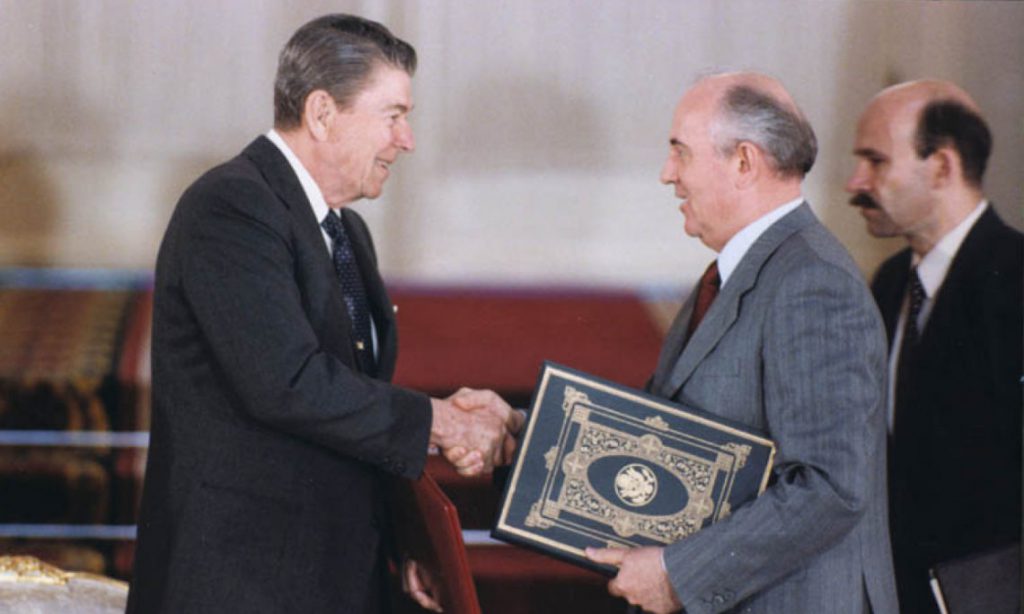
Waste Lands: America’s Forgotten Nuclear Legacy
The Wall St. Journal has compiled a searchable database of contaminated sites across the US. (view)
Related WSJ report: https://www.wsj.com
2022 BLOG POSTS
Nothing Found
It seems we can’t find what you’re looking for. Perhaps searching can help.
New & Updated
Watchdogs Call for Renewed Investigation of Corruption at Los Alamos Lab
For immediate release February 2, 2016
Watchdogs Call for Renewed Investigation of Corruption at Los Alamos Lab and Questionable Suicide of Former Deputy Director
Santa Fe, NM – Today three well-known whistleblowers sent a certified letter to Mr. Damon Martinez, the US Attorney for the District of New Mexico, asking him to reopen an investigation into fraud and corruption at the Los Alamos National Laboratory (LANL) and the questionable suicide in 2002 of the then-recently retired Lab Deputy Director. Mr. Damon is the top federal law enforcement official in New Mexico, and also serves as the Chair of the National Lab/Research University Working Group for US Attorneys. Therefore, he should be uniquely qualified to address the whistleblowers’ concerns.
Glenn Walp and Steve Doran were hired in 2002 by LANL to investigate fraud at the Lab after it had been repeatedly rocked by security and corruption scandals. However, senior Lab officials summarily fired them without cause before they could complete their investigations. During their long careers in law enforcement they were respectively, among other things, Commissioner of Pennsylvania State Police and police chief of Idaho City, Idaho. The third whistleblower, Chuck Montaño, is a multi-credentialed auditor and investigator who worked at LANL for 32 years. He became a federally protected whistleblower after reporting accounting malpractice and abuses that he had witnessed for years, and for which Lab management retaliated against him.
In their letter to Mr. Martinez, the three whistleblowers state that their main concern is the need for law enforcement to fully investigate the claimed suicide in 2002 of LANL’s second-in-command, former Deputy Director of Operations Richard Burick. Specifically at issue was the gun found at the scene of his death, and the improbability of this particular type of handgun being left in the state and condition that it was found in if truly used in a suicide. Steve Doran, who is a highly qualified investigator, and other weapon experts have concluded that it is impossible that the gun in question would have landed where it did, with an open, undamaged chamber, had it been truly used in a suicide.
In the same period of time as Burick’s claimed suicide, the criminal investigation of major procurement fraud at LANL was derailed by the Lab’s hasty firing of Walp and Doran. This, in turn, prevented a congressional committee from learning the full scope of potential criminal activity. Since then, new information has emerged that possibly links the corruption to Burick’s suicide, which the three whistleblowers assert deserves serious investigation by federal law enforcement.
The whistleblowers are coming forth now with their letter to the US Attorney for New Mexico prompted in part by a recent article by the Project on Government Oversight (POGO), a respected national organization that investigates and publicizes government waste, fraud and abuse. The POGO article concluded that if there were ever to be full accountability at LANL, “a new investigation into Richard Burick’s alleged suicide would be a good place to start.”
Walp, Doran and Montaño are also motivated by the recent announcement by the National Nuclear Security Administration that the LANL management contract will be competed in 2017. Their concern is that a full and complete investigation is needed in order to clean house and help ensure that one of the premier nuclear weapons labs, long plagued by scandal, is properly managed in the future, free of any possible reoccurrence of fraud and corruption. They believe that it is imperative that decision makers know the full extent of what transpired in order to know how best to proceed with the award of the new contract. Without a deeper understanding and accountability before the award is made, it is possible that the LANL management contract will end up in the hands of those largely responsible for the cover-up of past mismanagement at the Los Alamos Lab, or even worse the possible obstruction of justice that occurred.
Former Pennsylvania State Police Commissioner Glenn Walp commented, “Unless the consortium contractors for the Los Alamos National Laboratory consciously and aggressively resolve their perpetual management and operational failings, the lab will remain a haven for crime, corruption and cover-ups; perhaps it is time to shut it down.”
Former Police Chief Steve Doran asserted, “Corruption at Los Alamos must be taken out at the roots and those responsible brought to justice. This will build a strong national laboratory system that can be both trusted and productive.”
Federally protected whistleblower Chuck Montaño added, “The Los Alamos Lab is a cash cow for the military-industrial complex, and because politicians are so beholden to these corporations, there’s zero accountability for the fraud, waste and abuse that keeps occurring in Los Alamos. We are seeking to end that by asking the US Attorney for New Mexico to intervene and go wherever the facts may take him. ”
# # #
The Walp/Doran/Montaño letter to Mr. Damon Martinez, US Attorney for New Mexico, is available at https://nukewatch.org/importantdocs/resources/Letter-NM-US-Attorney-LANL-fraud.pdf
The Project on Government Oversight’s article Once Upon a Time in Los Alamos is available at http://www.pogo.org/blog/2016/once-upon-a-time-los-alamos.html
Chuck Montaño’s book Los Alamos: Secret Colony, Hidden Truths chronicling his 32 years working at the Los Alamos Lab and becoming a federally protected whistleblower is available at http://losalamosdiary.com/index.html
Glenn Walp’s book Implosion at Los Alamos on his hiring and firing investigating corruption and fraud at the Los Alamos Lab is available at http://www.implosionatlosalamos.com/
Baseless Claims?
Baseless Claims?
In the January 20th, 2016 Albuquerque Journal article, Nuclear Watch to sue over LANL cleanup problems, by Mark Oswald, there is an interesting quote from New Mexico Environment Department (NMED) Secretary, Ryan Flynn, in response to our notice of intent to sue DOE/LANL.
“Flynn said Wednesday, “These are nothing more than baseless claims being peddled by a radical group that insists on wasting everybody’s time with empty threats and manufactured disputes, which helps them grab headlines and juices their fundraising efforts.””
The main point in Nuclear Watch New Mexico’s Notice of Intent to sue is based on the calendar. In particular, the mandatory final compliance report that was to be submitted under the 2005 Consent Order Compliance Schedule was to be submitted by December 6, 2015.
The report was not submitted by December 6, 2015.
It is now January 25, 2016, which is after December 6, 2015.
The final report is late – see calendar.
The federal law that was incorporated into the 2005 Consent Order, and the Consent Order itself, specify certain actions that must be taken when a deliverable does not meet its due date. For instance, DOE/LANL must request an extension. In the case of extending this final scheduled compliance deadline, there are “Class 3” permit modification requirements, like the opportunity for a public hearing, that are required.
Interestingly, because NukeWatch believes that the ball is DOE/LANL’s court to request an extension of time for the December 6, 2015 report, NMED is not named in our notice of intent to sue.
Nuclear Watch NM Gives Notice of Intent to Sue Over Lack of Cleanup at the Los Alamos Lab
Nuclear Watch NM Gives Notice of Intent to Sue
Over Lack of Cleanup at the Los Alamos Lab
Nuclear Watch New Mexico has notified the Department of Energy (DOE) and the Los Alamos National Laboratory (LANL) that it will file a lawsuit over their failure to meet cleanup milestones under a “Consent Order” governed by the New Mexico Environment Department. Formal notice is required before a lawsuit can actually be filed, which NukeWatch intends to do within 60 days or less. The New Mexico Environmental Law Center is representing NukeWatch in this legal action to enforce cleanup at LANL.
Jay Coghlan, NukeWatch Executive Director, commented, “The nuclear weaponeers plan to spend a trillion dollars over the next 30 years completely rebuilding U.S. nuclear forces. Meanwhile, cleanup at the Los Alamos Lab, the birthplace of nuclear weapons, continues to be delayed, delayed, delayed. We are putting the weaponeers on notice that they have to cleanup their radioactive and toxic mess first before making another one for a nuclear weapons stockpile that is already bloated far beyond what we need. Real cleanup would be a win-win for New Mexicans, permanently protecting our water and environment while creating hundreds of high paying jobs.”
Last week Nuclear Watch NM broke a story on how LANL and DOE have formally given the green light for new underground facilities to expand the production of plutonium pits (the fissile triggers of modern H-bombs) from the currently approved level of 20 pits per year to 80. In all, upgrades to existing plutonium facilities at LANL and the construction of two underground “modules” that can be added to later for yet more production will cost at least $4 billion. The environmental impact statement for a previously proposed Walmart-sized plutonium facility (canceled because of costs that exploded up to $6.5 billion dollars) documented that not a single new Lab job would be created because it would simply relocate existing jobs. Full cleanup, on the other hand, would be labor intensive and create hundreds of high paying jobs for several decades.
Every year the estimated cost of nation-wide “environmental liabilities” from past nuclear weapons research and production, currently $298 billion, outpaces the annual levels of environmental restoration funding actually spent, even though those estimated liabilities don’t include full cleanup to begin with. At the same time, one multi-billion dollar DOE cleanup project after the other fails, for example the $13.5 billion Waste Treatment Plant at the Hanford nuclear reservation, the multi-billion dollar Waste Isolation Pilot Plant in southern New Mexico (closed because of a ruptured radioactive waste barrel from LANL), and the estimated $2.6 billion spent to date for incomplete cleanup at LANL. As an example of local impacts, during major stormwater events the City of Santa Fe has to close water diversion on the Rio Grande that can supply up to 15 million gallons per day of drinking water because of plutonium contamination in Los Alamos Canyon. Meanwhile, nation-wide, thousands of sick Cold War workers and downwinders from nuclear weapons tests await long delayed health benefits and compensation.
LANL is key to the trillion dollar rebuilding of nuclear forces as the premier nuclear weapons design lab and the nation’s sole production site for plutonium pit triggers, the most critical nuclear weapons components. Funding for DOE nuclear weapons programs is nearly double historic Cold War averages, with around $1.5 billion spent annually at LANL alone. In contrast, funding for Lab cleanup remains flat at around $185 million per year, with only approximately a third going to actual cleanup (one-third goes to pensions and another third to safeguarding improperly prepared radioactive waste barrels destined for the now-closed WIPP). New Mexico Environment Department (NMED) officials have publicly stated that around $250 million per year is needed for effective cleanup at LANL.
The 2005 Consent Order required DOE and LANL to investigate, characterize, and clean up hazardous and mixed radioactive contaminants from 70 years of nuclear weapons research and production. It also stipulated a detailed compliance schedule that the Lab was required to meet. Ironically, the last milestone, due December 6, 2015, required a report from LANL on how it successfully cleaned up Area G, its largest waste dump. However, real cleanup remains decades away, if ever. The Lab plans to “cap and cover” Area G, thereby creating a permanent nuclear waste dump in unlined pits and shafts, with an estimated 200,000 cubic yards of toxic and radioactive wastes buried above the regional groundwater aquifer, four miles uphill from the Rio Grande.
In the past the New Mexico Environment Department had repeatedly stated that it would release a revised Consent Order with new compliance dates before the end of 2015. Last November NMED Secretary Ryan Flynn said that a draft revised Consent Order would not be released until settlements were finalized over LANL violations of waste handling procedures that led to the closure of WIPP. Those settlement negotiations are still ongoing, leaving the Consent Order governing cleanup at the Lab in legal limbo.
Under typical hazardous waste handling permits, federal regulations require that an extension of a final compliance date include “an opportunity for a public hearing at which all interested persons shall be given a reasonable chance to submit data, views or arguments orally or in writing and to examine witnesses testifying at the hearing.” While the 2005 Consent Order is not a permit per se, it nevertheless explicitly incorporated the public process requirements of a federal hazardous waste permit. Therefore, Nuclear Watch New Mexico believes that any revised Consent Order requires an opportunity for meaningful public participation during its negotiation, leading to a public hearing should there be any unresolved issues, a position which so far NMED has opposed.
Scott Kovac, Nuclear Watch NM Research Director, said, “DOE, LANL and NMED have had four years to involve the public in revising Consent Order cleanup decisions and comnpliance dates at the Lab, but yet they seem to have ignored the final deadline. Northern New Mexicans want meaningful input into cleanup decisions at LANL. NukeWatch believes that a rigorous cleanup schedule must be stipulated from the beginning in any revised Consent Order, and that the Lab must be held accountable every step along the way for getting the necessary funding and doing the work on time. We insist upon meaningful public participation and dates certain for compliance milestones. Cleanup at the Los Alamos Lab cannot be open-ended or it will never be accomplished.”
# # #
Nuclear Watch New Mexico’s Notice of Intent to Sue is available at https://nukewatch.org/importantdocs/resources/NukeWatch-NM-NOI-to-DOE-and-LANS-20160120.pdf
Budget data are from the Department of Energy’s annual Congressional Budget Requests.
The current estimate of $298 billion to cleanup past nuclear weapons research and production comes from the DOE Agency Financial Report for Fiscal Year 2014. Even that figure does not come anywhere close to full and complete cleanup, but instead often involves “cap and cover” and leaving nuclear wastes permanently in place.
The quote concerning the need for a public hearing was incorporated into New Mexico state law NMSA 1978, §74-4-4.2(H) (2006).
NukeWatch Gives Notice of Intent to Sue Over Lack of Cleanup at Los Alamos
Santa Fe, NM.
Today, Nuclear Watch New Mexico notified the Department of Energy (DOE) and the Los Alamos National Laboratory (LANL) that it will file a lawsuit over their failure to meet cleanup milestones under a “Consent Order” governed by the New Mexico Environment Department. Formal notice is required before a lawsuit can actually be filed, which NukeWatch intends to do within 60 days or less. The New Mexico Environmental Law Center is representing NukeWatch in this legal action to enforce cleanup at LANL.
Jay Coghlan, NukeWatch Executive Director, commented,
“The nuclear weaponeers plan to spend a trillion dollars over the next 30 years completely rebuilding U.S. nuclear forces. Meanwhile, cleanup at the Los Alamos Lab, the birthplace of nuclear weapons, continues to be delayed, delayed, delayed. We are putting the weaponeers on notice that they have to cleanup their radioactive and toxic mess first before making another one for a nuclear weapons stockpile that is already bloated far beyond what we need. Real cleanup would be a win-win for New Mexicans, permanently protecting our water and environment while creating hundreds of high paying jobs.”
See also: Notice of Intent Letter
National Nuclear Security Administration Gives Green Light For Expanded Plutonium Pit Production at Los Alamos
For immediate release January 15, 2016
Contacts: Jay Coghlan, NWNM, 505.989.7342, c. 505.470.3154, jay[at]nukewatch.org
National Nuclear Security Administration Gives Green Light
For Expanded Plutonium Pit Production at Los Alamos
Santa Fe, NM – Today the Defense Nuclear Facilities Safety Board, an independent agency commissioned by Congress, posted a weekly report that makes explicit a decision by the National Nuclear Security Administration (NNSA) to expand plutonium pit production at the Los Alamos National Laboratory (LANL). Plutonium pits are the fissile cores or “triggers” of modern two-stage thermonuclear weapons, but they are also atomic weapons in their own right (a plutonium bomb incinerated Nagasaki in August 1945). Plutonium pit production has always been the chokepoint preventing industrial-scale U.S. nuclear weapons production ever since a FBI raid investigating environmental crimes shut down the notorious Rocky Flats Plant near Denver in 1989.
Jay Coghlan, Nuclear Watch Director, commented, “Expanded plutonium pit production at the Los Alamos Lab is really all about future new-design nuclear weapons with new military capabilities produced through so-called Life Extension Programs for existing nuclear weapons.” The relevant case-in-point is that LANL is now tooling up to produce pits for one type of warhead (the W87) to use in an “Interoperable Warhead” that will combine two other warheads (the W78, a land-based ICBM warhead, and the W88, a sub-launched warhead), clearly a radically new design even if as claimed only existing nuclear weapons components are used.
Coghlan further commented, “The real irony is that this Interoperable Warhead has been delayed for at least five years, if not forever, because of its enormous estimated expense and Navy skepticism. Yet this doesn’t keep LANL and the NNSA from spending billions of taxpayer dollars to upgrade existing and build new production facilities for unnecessary and provocative expanded plutonium pit production.”
Specifically, NNSA and LANL seek to raise the administrative limit on plutonium in the existing Radiological Lab (“RLUOB” in the Safety Board report below) from an original 8.4 grams to 400 grams, and proceed with the “Plutonium Modular Approach project.” In 2012, in the face of exploding costs and rising citizen opposition, NNSA dropped its proposal to build a $6.5 billion Walmart-sized “Chemistry and Metallurgy Research Replacement Project-Nuclear Facility” for expanded plutonium pit production of up to 80 pits per year. There was no technical justification for this expanded production, other than unspecified “Department of Defense requirements.”
These new moves by NNSA and LANL, which will cost around $4 billion before the usual cost overruns, are just another way to achieve their goal of raising plutonium pit production to up to 80 plutonium pits per year. Raising the amount of plutonium in the Radiological Lab will enable LANL to conduct all needed analytical chemistry quality control samples of new pits, as the Safety Board memo says to “primarily support the increased capacity required for larger pit manufacturing rates.” The Plutonium Modular Approach project will be newly constructed underground facilities for hot operations such as a plutonium foundry, likely beginning with two modules at a billion dollars each. It should be noted that proposed major federal actions require the opportunity for public review and comment under the National Environmental Policy Act, which has not been done for what NNSA calls this alternative plutonium strategy. Nevertheless, increased funding for LANL’s plutonium infrastructure will be likely included in the pending federal budget for FY 2017, scheduled to be released Monday February 9.
There is no need for expanded plutonium pit production to maintain the safety and reliability of the existing nuclear weapons stockpile, but it is vital for future new-designs that the nuclear weaponeers want. In fact, the U.S. government is planning to spend a trillion dollars over the next 30 years to “modernize” and completely rebuild its nuclear forces, despite its pledge in the 1970 NonProliferation Treaty to enter into serious negotiations leading to nuclear disarmament.
Background
In 1996 the plutonium pit production mission was formally relocated to LANL, with an approved upper limit of 20 pits per year. NNSA has tried four times since then to expand plutonium pit production. This started with a proposed “Modern Pit Facility” capable of producing up to 450 pits per year, with no justification of why that Cold War-like level of production was needed. In all four cases, in response to successful citizen activism, Congress either rejected or NNSA dropped efforts to expand production, in large part because of a pit life study that New Mexico Senator Jeff Bingaman required at Nuclear Watch’s request. That 2006 study by independent experts found that plutonium pits last at least 100 years (with no proscribed end date), more than double NNSA’s previous estimates of 45 years.
Nevertheless, NNSA now seeks for the fifth time to expand plutonium pit production beyond the currently approved level of 20 pits per year at LANL. After having produced 30 pits for the W88 sub-launched warhead (which was in production when the Rocky Flats Plant was shut down), there are no current requirements for plutonium pit production to maintain stockpile safety and reliability.
In the meanwhile, funding for cleanup at the Los Alamos Lab is being cut, while nuclear weapons programs that caused the mess to begin with are thriving. As a final irony, these plans to expand plutonium pit production are now being implemented, despite the fact that 1) major operations at LANL’s main plutonium facility have been suspended since June 2013 because of nuclear criticality safety concerns; and 2) the Los Alamos Lab has no place to send its radioactive plutonium pit production wastes ever since it sent a drum that ruptured and closed down the multi-billion dollar Waste Isolation Pilot Plant.
Nuclear Watch New Mexico is confident that this latest attempt to expand plutonium pit production will fall apart as well, but only as a result of continuing strong citizen activism.
# # #
• Relevant excerpt from Defense Nuclear Facilities Safety Board Weekly LANL Report:
http://www.dnfsb.gov/sites/default/files/Board%20Activities/Reports/Site%20Rep%20Weekly%20Reports/Los%20Alamos%20National%20Laboratory/2015/wr_20151218_65.pdf
Los Alamos Report for Week Ending December 18, 2015
MEMORANDUM FOR: S.A. Stokes, Technical Director FROM: R.K. Verhaagen and J.W. Plaue
DNFSB Staff Activity: R. L. Jackson was onsite to plan oversight activities associated with Plutonium Infrastructure Strategy. Accordingly, he met with key project staff and walked down the Plutonium Facility, the Chemistry and Metallurgy Research (CMR) building, and the Radiological Laboratory Utility Office Building (RLUOB).
Plutonium Infrastructure Strategy: Late last month, the Deputy Secretary of Energy approved a restructuring of the subprojects covered under the CMR Replacement project. There are now four subprojects: (1) RLUOB Equipment Installation, Phase 2; (2) Plutonium Facility Equipment Installation, Phase 1; (3) Plutonium Facility Equipment Installation, Phase 2; and (4) Re- categorizing the RLUOB to Hazard Category 3 with a material-at-risk limit of 400 g plutonium- 239 equivalent. The first two subprojects enable LANL to cease programmatic activities in the CMR by 2019, while the latter two subprojects primarily support the increased capacity required for larger pit manufacturing rates. The memo requests an updated project execution plan within 90 days and indicates approval authority will remain with the DOE Deputy Secretary for subprojects 2–4 and with the NNSA Administrator for subproject 1.
In a separate action, the DOE Deputy Secretary also approved the mission need Critical Decision (CD)-0 for the Plutonium Modular Approach project. This project addresses life extension needs for the existing Plutonium Facility in support of Department of Defense requirements and Congressional Direction. The CD-0 schedule range for project completion is December 2025 to December 2027.
• For an extensive history of successful citizen activism against plutonium pit production see https://nukewatch.org/facts/nwd/Pit-Production-History.pdf
National Nuclear Security Administration Gives Green Light For Expanded Plutonium Pit Production at Los Alamos
Santa Fe, NM.
Today the Defense Nuclear Facilities Safety Board, an independent agency commissioned by Congress, posted a weekly report that makes explicit a decision by the National Nuclear Security Administration (NNSA) to expand plutonium pit production at the Los Alamos National Laboratory (LANL). Plutonium pits are the fissile cores or “triggers” of modern two-stage thermonuclear weapons, but they are also atomic weapons in their own right (a plutonium bomb incinerated Nagasaki in August 1945). Plutonium pit production has always been the choke point preventing industrial-scale U.S. nuclear weapons production ever since a FBI raid investigating environmental crimes shut down the notorious Rocky Flats Plant near Denver in 1989.
Jay Coghlan, Nuclear Watch Director, commented,
“Expanded plutonium pit production at the Los Alamos Lab is really all about future new-design nuclear weapons with new military capabilities produced through so-called Life Extension Programs for existing nuclear weapons.” The relevant case-in-point is that LANL is now tooling up to produce pits for one type of warhead (the W87) to use in an “Interoperable Warhead” that will combine two other warheads (the W78, a land-based ICBM warhead, and the W88, a sub-launched warhead), clearly a radically new design even if as claimed only existing nuclear weapons components are used.
LANL In No Hurry With Emergency Response Plans
LANL In No Hurry With Emergency Response Plans
In the recent letter, the Defense Nuclear Facilities Safety Board told DOE that they were concerned with the pace and completeness of the emergency preparedness and response efforts at Los Alamos National Laboratory (LANL). The Board is an independent organization that provides recommendations and advice regarding public health and safety issues at Department of Energy (DOE) defense nuclear facilities.
After LANL recently confessed “[a] sustainable, comprehensive, and coordinated training and drills program has not been fully implemented as required” per DOE requirement Comprehensive Emergency Management System, the Board staff made some preliminary observations indicating weaknesses in emergency preparedness and response at LANL. And the Safety Board plans to perform a comprehensive review of emergency preparedness and response programs at LANL in early 2016.
Some of the preliminary observations were –
- The emergency response plans that involve the inappropriately remediated nitrate salt drums, like the one that exploded and shut down WIPP, have not been updated to reflect the current understanding of the release hazards. Consequently, pre-planned evacuation zones may be not be large enough for members of the public in the event of an accident.
- Planning and conduct of emergency drills and exercises do not ensure that scenarios are sufficiently challenging and minimize artificiality and simulation and do not represent the full spectrum of credible accident types.
- Exercises show the inability to effectively shelter laboratory workers in place during a release of hazardous materials.
- Radios don’t work much of the time.
These types of problems should not consistently be showing up where safety is a priority. It will be interesting to see how much of a factor these emergency preparedness issues played in LANS, the current Lab for-profit management contractor, losing its job.
We hope the new LANL contractor can keep safety first.
Federal Nuclear Safety Oversight at LANL Remains Drastically Understaffed
Federal Nuclear Safety Oversight at LANL Remains Drastically Understaffed
A recently released report, Office of Enterprise Assessments Targeted Review of Work Planning and Control and Biological Safety at the Los Alamos National Laboratory (LANL), December 2015, explains nuclear safety oversight staffing shortages.
The Office of Enterprise Assessments (EA) is the Department of Energy’s (DOE) organization responsible for assessments of nuclear and industrial safety, and cyber and physical security. DOE has regulatory authority over the radiologic facilities, operations, and wastes of the nuclear weapons complex. (Whereas the State of New Mexico has regulatory authority over non-radiological, hazardous operations and wastes.)
LANL is managed and operated by Los Alamos National Security, LLC with oversight by DOE’s Los Alamos Field Office (NA-LA). On a good day, NA-LA, with around 100 total on staff, would have their hands full providing oversight for LANS’ 13,000 employees and contractors scattered over nearly 40 square miles.
Lack of Safety Oversight Staff, with No Help in Sight
But the recent report (which was investigated in June and July, 2015) explains that NA-LA has funding for only 6 out of the 12 (at the least) required Facility Representative (FR) positions. An FR is defined as an individual assigned responsibility by the local field office for monitoring the safe and efficient performance of a facility and its operations. This individual is the primary point of contact with the contractor for operational and safety oversight.
DOE has a process to determine adequate Facility Representative staffing. The NA-LA FR staffing analysis for 2015 indicated that 17 FRs are needed to cover 13 Hazard Category 2 nuclear facilities, 4 Hazard Category 3 nuclear facilities, 11 High Hazard facilities, 12 moderate hazard facilities, and 7 low hazard facilities. NA-LA figured that only 12 FRs were needed and that 10 were on board. However the current NA-LA organization chart shows 7 FRs, one of whom has been on detail as the acting chief of staff for over a year and has not maintained his FR qualifications. There are no current plans to fill the vacancies. Due to staffing shortages, FR oversight is limited to the nuclear facilities. The bottom line is that the current NA-LA staffing level is 6 FRs fewer than the requirement of 12 stated in the Work Force Analysis and Staffing Plan Report. (Pg. 25)
This staff shortage is exacerbated by the fact that NA-LA has not approved LANS’ contractor assurance system (CAS), which is required by DOE orders. DOE’s version of Contractor Assurance is a contractor-designed and utilized system to manage performance consistent with contract requirements. The system provides transparency between the contractor and DOE to accomplish mission needs, and for DOE to determine the necessary level of Federal oversight.
A rigorous and credible assessment program is the cornerstone of effective, efficient management of programs such as environment, safety, and health; safeguards and security; cyber security; and emergency management.
The NA-LA oversight processes include an evaluation of the CAS primarily through staff assessments. Also, NA-LA annually approves the annual performance evaluation plan, which is an element of the CAS system.
It is NA-LA’s oversight of the 2015 Performance Evaluation Report (which has not yet been publically released) that lead to DOE ending LANS’ contract at LANL in 2017. We give a tip of the hat to NA-LA for being so diligent about poor LANL performance while being so short-handed. It makes me wonder what other problems may be as yet undiscovered. Would the LANL waste drum packing mistake, which shut down the Waste Isolation Pilot Plant (WIPP), have been caught if NA-LA was fully staffed? The estimated cost of reopening WIPP is $.5 billion and climbing.
It is irresponsible for DOE not to provide its Los Alamos Field Office with its required staffing and resources. The lack of oversight is not only dangerous. It can be expensive.
NukeWatch insists that Federal safety oversight of DOE nuclear and hazardous activities be the first priority. Fully staffed oversight is essential for worker and public safety. This will be especially important as the new contractor takes over operations of LANL in 2017.
Taxpayers con not afford to have any less in place.
Governor Udall?
Governor Udall?
Michael Coleman had an interesting article for the Albuquerque Journal – Does New Mexico’s future lie in D.C.?
Coleman relates a conversation with NM Senator Tom Udall that made it clear the Senator isn’t ruling a gubernatorial run out.
It’s not surprising to think that Udall – who has been in Washington as a congressman and U.S. senator since 1998 – might want to come home to beautiful Santa Fe and take up residence in the governor’s mansion as a coda to his long political career.
Just two years into his second six-year term in the Senate, Udall could run for governor without giving up his Senate seat, which doesn’t expire until 2020. If he won the 2018 governor’s race, he would appoint his Senate replacement. That kind of power is alluring to any politician.
But as Coleman says, “it’s all just a parlor game at this point.”
Despite Uncertainty of When/If WIPP Will Reopen, DOE Hatches Plan to Send More Waste
Despite Uncertainty of When/If WIPP Will Reopen,
DOE Hatches Plan to Send More Waste
In a recent Albuquerque Journal Editorial Board Editorial: Another WIPP delay spells more tax dollars wasted, we are reminded of the delays affecting the reopening of the Waste Isolation Pilot Plant (WIPP), which has not been disposing radioactive waste since February 2014 when an improperly packed drum from Los Alamos exploded.
Almost two years later, the WIPP contractor struggles to figure out how to clean and reopen the underground repository. Serious concerns revolve around the ventilation system, which not cannot supply the required amount of air now because it must be operated in filter mode ever since WIPP was contaminated.
As the Journal editorial explains,
So while the delays pile up, so do cleanup and reopening costs, which may exceed $500 million.
With bumbling progress like this, it remains to be seen if WIPP will ever reopen.
Yet surprisingly, DOE just released a plan to send MORE waste to WIPP.
A Federal Register notice announces the DOE selection of a Preferred Alternative to prepare 6 metric tons (MT) of surplus non-pit plutonium for eventual disposal at WIPP.
In the Final Environmental Impact Statement (EIS), issued to the public in May 2015, DOE describes the potential environmental impact from alternatives for safe and timely disposition of 13.1 metric tons (14.4 tons) of surplus plutonium for which a disposition pathway is not yet assigned. When the Final EIS was issued, DOE had no Preferred Alternative for the disposition of the 6 metric tons (6.6 tons) of surplus non-pit plutonium.
The Federal Register Notice for DOE/NNSA’s Preferred Alternative for Disposition of Surplus Non-pit Plutonium for the Final Surplus Plutonium Supplemental EIS is expected to be published in the Federal Register by Thursday, December 24, 2015. The Final SPD Supplemental EIS and related information, including the Federal Register notice will also be available on the SPD Supplemental EIS website, and the DOE National Environmental Policy Act website.
Since WIPP doesn’t have capacity (even if it re-opens) for this additional waste, putting it into WIPP would, among other things, displace waste from other site(s) – Idaho, Hanford, Los Alamos, or Oak Ridge.
The Record of Decision will not be released for at least 30 days. Comments are not requested, but can be made, regarding the notice.
Our friends at Southwest Research and Information Center will be making additional comments about this proposed expansion of WIPP.
The WIPP contractor has much to do before the repository can safely reopen. The task may be unachievable. But in the meantime, expanding WIPP’s mission can only make reopening WIPP more schedule driven instead of safety driven.
If DOE wants to make useful plans, how about plans for WIPP’s replacement?
Four Strikes and You’re Out
Four Strikes and You’re Out
In stunning news on December 18, Justin Horwath of the SF New Mexican reported that the management and operating contractor of Los Alamos National Laboratory will not have its contract renewed after it ends Sept. 30, 2017. This is stunning because LANS LLC, the M&O contractor, could have potentially run the Lab until for 20 years until 2026, had it not had so many problems.
The annual contract for FY 2016 was over $2.2 billion. This means that Los Alamos National Security (LANS) left upwards of $20 billion (9 years of lost contract) on the table. It’s not often that a company gets the opportunity to make mistakes that costs them $20 billion worth of contracts.
The management of the Lab was privatized when LANS was awarded the contract in 2005. LANS is a partnership between the University of California, Bechtel Corp., Babcock & Wilcox Co., and AECOM (formerly URS). Before 2005 the University of California exclusively managed LANL as a non-profit. The for-profit experiment for managing the Lab will hopefully be reconsidered.
As a reminder, Nuclear Watch NM, along with our friends at Tri-Valley CARES, submitted a bid to manage the Lab back in 2005. We thought the management should be non-profit and that nuclear weapons research should be phased out.
The overall direction of future missions at the Los Alamos National Laboratory (LANL) – We propose to downgrade the Lab’s nuclear weapons programs and subordinate them under a new Associate Directorship of Nuclear Nonproliferation so that it can be better assured that national and international obligations under the NonProliferation Treaty are met.
LANS lost the M&O contract because they failed to earn the “award term” 4 times. The award term is simply another year added to the contract. Section H-13(f) of the current contract states, ‘If the Contractor fails 4 times to earn award term, the operation of this Award Term clause will cease.”
Then, LANS lost award term in 2014 AND had one extra award term that was previously earned taken away because of improperly packing the radioactive waste drum that shut down WIPP.
And LANS lost this award term for 2015. LANL may be negotiating this, but they got a waiver in 2012 that granted them an award term when they didn’t actually earn it. They were told that was their last waiver.
That’s four.
These award terms are based on the Lab’s Performance Evaluation Reports (PERs), which thanks to a successful Freedom of Information Act lawsuit by NukeWatch, are available online. We wonder if having these available to the public could have helped the National Nuclear Security Administration (NNSA) in any way to not give the award terms.
We do thank NNSA and the DOE LA Field Office for sticking to their guns by providing genuine oversight of the Lab this go-around. But the past few years serve as a reminder of the dangerous and difficult side of nuclear weapons work, the continuing health impacts to workers, and the impossibility of isolating the radioactive waste for hundreds of thousands of years. When will the US decide that it’s just not worth it?
The SF New Mexican also tells that NM Congressional delegation has weighed in. We agree with the joint statement issued by U.S. Sens. Tom Udall and Martin Heinrich and U.S. Rep. Ben Ray Luján that, “DOE must hold all of its contractors accountable and be responsible stewards of federal funds.”
But we have some questions about this statement:
“Los Alamos National Laboratory employs some of the best and brightest minds in the country whose contributions are indispensable to our national security. The lab also strengthens our economy by providing quality jobs, and we will always fight to protect its mission. As DOE prepares a new contract proposal, assuring continuity for the employees at LANL and the high-quality scientific, energy, and security contributions they make to our nation will be paramount. We are confident that Los Alamos will continue to have a critical role in national and international security, research and science. We expect to receive further details and regular briefings from NNSA as the process moves forward in the new year.”
The delegation’s joint letter seems to demonstrate how overly concerned they are with LANL’s “mission” of nuclear weapons production and with the institutional benefit of profit-making national security contractors. The Lab’s actual contributions to energy research and basic science are also a small proportion to the taxpayer dollars expended there.
A major rewrite of the Lab’s missions is needed where true national security is not based on nuclear weapons.
LANL contract up for bid after 2017
NukeWatch comment:
As the trillion dollar “modernization” of U.S. nuclear forces moves forward, note how hollow the Department of Energy infrastructure is because of contractor greed, incompetence and waste. While that alone won’t win the day for us, I do expect it to limit the scale and timing of “modernizing” the DOE nuclear weapons complex (“modernization” means the indefinite preservation of the nuclear weapons stockpile and its supporting research and production infrastructure, contrary to official U.S. policy that endorses a future world free of nuclear weapons). This includes Life Extension Programs that give existing nuclear weapons new military capabilities despite denials at the highest levels of the U.S. government, and new production facilities such as the Uranium Processing Facility at the Y-12 Plant near Oak Ridge, TN and plutonium facilities at Los Alamos which face constant cost overruns.
There could also possibly be developments in the first quarter of next year related to its illegal lobbying activities that would shake up Lockheed Martin’s grip on the Sandia Labs (the Sandia contract is also scheduled to be put up for bid). In short, 2016 could be a very fluid and unstable year for the DOE nuclear weapons complex, even as it seeks to put the B61-12 smart nuclear bomb into production and move forward aggressively on a nuclear warhead for a new first-strike air-launched cruise missile.
Jay Coghlan, Executive Director
***********
LANL contract up for bid after 2017
By Mark Oswald / Albuquerque Journal Staff Writer
Friday, December 18th, 2015 at 11:40pm
SANTA FE – The National Nuclear Safety Administration has informed
Congress that the Los Alamos National Laboratory contract will be put
out for competitive bidding sometime after 2017, the Journal has learned.
It would be only the second time the contact has been put out to bid
since the lab was created to develop the atomic bomb during World War II.
LANL’s most recent federal government performance evaluation is better
than last year’s, but not good enough for the lab’s private-sector
operator to earn the award of an extra year on its contract, the lab’s
director informed LANL workers this week.
And continuation of Los Alamos National Security LLC holding the
contract was contingent on it being granted the “award term.”
LANL director Charles McMillan said in his Thursday email to lab
employees that he was “deeply disappointed that we did not meet NNSA’s
expectations in a manner sufficient to net another year of award term”
on the contract that runs through fiscal year 2017.
“Nevertheless, the federal government has offered Los Alamos National
Security, LLC (LANS) an extension to the contract to manage the
Laboratory beyond FY17; I will provide additional details about that at
a later date after there has been more discussion between the federal
government and LANS,” McMillan said in a copy of his message obtained by
the Journal.
An extension as described by McMillan is not the same thing as the
merit-based award of an additional contract year that LANS missed out on
this year. It’s unclear from McMillan’s statement whether the extension
he mentioned is intended as merely a holding pattern but, under its
contract, LANS needed to earn an award year this time around to keep the
contract going.
The contract with LANS provides for vacating the contract, awarded in
2006, if the consortium doesn’t earn a series of one-year term awards.
Last year, the Department of Energy – NNSA’s parent organization –
warned that LANS was under the gun to earn an award term for its work in
fiscal 2015.
“Having failed to earn contract term extensions for fiscal years 2013
and 2014,” and with the revocation of a previous extension, “LANS must
earn (an) award term in every future performance period to keep the
contract in force beyond fiscal year 2017,” said a statement provided by
the DOE last December.
On Friday, an NNSA spokeswoman said, “We do not comment on ongoing
assessments.”
Contract over $2 billion
LANS – a consortium that includes the Bechtel corporation, the
University of California, Babcock and Wilcox, and URS Energy and
Construction – won the LANL contract in 2006. The contract now amounts
to about $2.2 billion a year, plus a fee based on performance.
The University of California, on its own, had previously held the Los
Alamos contract since the lab’s beginnings developing the atomic bomb
during World War II. The contract was put out for competition about a
decade ago after a series of security and property management problems
at the lab.
Last year, LANS also didn’t earn an “award term” and even lost a year it
had previously been granted as NNSA hit the lab hard for failures that
led to a radioactive leak at the nation’s nuclear waste repository near
Carlsbad from a drum packaged at Los Alamos. The Waste Isolation Pilot
Plant has been shut down since the leak in February 2014.
The federal government cut the performance-based management fee for LANS
by nearly 90 percent, down to $6.25 million, for fiscal 2014. That
compared with $59 million-plus paid to the LANS consortium the previous
two years. No information on the 2015 fee award has been released.
McMillan’s Thursday message to employees said that, in order to earn an
award year, the lab had to score better than “satisfactory”in all of
six evaluation categories. “We did not accomplish this,” McMillan said,
despite getting high scores in four of the six areas.
NNSA rated LANS only satisfactory for operations and infrastructure, the
same category in which the lab got a crucial “unsatisfactory” grade last
year. LANS this year was rated “very good” in two categories – its
missions to manage nuclear weapons and reduce global nuclear security
threats – and excellent in two others, missions for science technology
and engineering, and for a “DOE and Strategic Partnership Project.” The
NNSA rated LANS’s leadership as “good.”
Despite his disappointment over failing to net an award term, McMillan
wrote, “I am pleased to note that our federal partners once again
acknowledged our strong performance in the areas of mission and science.
We continue to provide strong value to the national security missions
and Los Alamos continues to be regarded highly for the quality of its
science.
‘Shortcomings’ noted
“Our federal partners made it clear that shortcomings in our work
planning and work controls related to safety events, project
performance, cybersecurity, the earned value management system (EVMS)
and continued weaknesses in criticality safety all weighed heavily in
the evaluation of our performance. These are areas we must – and will –
improve going forward,” said McMillan.
He also wrote, “I remain committed to the long-term sustainability of
the Laboratory and to each of you. I am scheduling an all-employee
meeting shortly after the New Year to hear and address your thoughts,
concerns, and questions. Los Alamos will continue to have a valued role
in protecting the nation and the world. It is incumbent upon us during
the remainder of the contract period to deliver mission success through
operational effectiveness and scientific excellence.”
Jay Coghlan of the Nuclear Watch New Mexico watchdog group said the
situation as described by McMillan, with LANS getting an extension
despite failing to earn an award term, was “deja vu all over again,”
similar to a later-rescinded waiver that granted LANS an award year for
fiscal 2012, although it hadn’t met all the performance criteria. “It
seems awfully premature for director McMillan to indicate there’s going
to be a contract extension before it’s actually finalized by the U.S.
government,” Coghlan said. “He’s putting the cart before the horse,
maybe putting on a happy face for his employees before they leave for
Christmas.”
Feds won’t renew contract for private LANL operator
Posted: Friday, December 18, 2015 9:30 pm | Updated: 10:24 pm, Fri Dec 18, 2015.
By Justin Horwath
The New Mexican | 0 comments
The private consortium that runs Los Alamos National Laboratory will not have its contract renewed after it ends Sept. 30, 2017, The New Mexican has learned. The consortium is currently in negotiations with the federal government that could extend the $2.2 billion annual contract beyond 2017, even as the contract is put back up for bid, according to a person familiar with the discussions.
The decision not to renew the contract follows a blistering series of federal investigations and performance evaluations involving the lab’s safety record after a drum from the lab burst and leaked radiation at the Waste Isolation Pilot Plant in February 2014 near Carlsbad, shutting down the nation’s only underground nuclear repository indefinitely.
The Department of Energy notified staffers with the New Mexico congressional delegation about the decision to put the contract up for bid on Friday, according to the person, who spoke on condition of anonymity because he was not authorized to discuss the matter. Members of the delegation were not available for comment Friday evening.
Lab officials did not immediately return calls seeking comment Friday evening.
The lab has been run since 2006 by Los Alamos National Security, which took over operations after years of accounting scandals, security lapses and other management issues. The company is made up of a partnership between the University of California, Bechtel Corp., Babcock & Wilcox Co., URS Corp. and AECOM.
But the consortium repeatedly has run into its own problems over the past several years. In 2013, the National Nuclear Safety Administration, the arm of the Department of Energy that oversees the lab’s contract, denied LANS a one-year extension of its contract to operate the lab because it fell short of its goals for repairing and reopening some weapons facilities. Still, the NNSA awarded LANS about $52 million in performance fees, or 87 percent of the full amount possible in 2013.
Then, last December, the NNSA issued a stinging performance evaluation in the wake of the WIPP leak. In that evaluation, the lab received grades of “unsatisfactory” in key areas that cost the consortium a year on its contract and about $57 million in incentives.
The lab has received the results of its latest performance evaluation for 2015, according to an internal memo obtained byThe New Mexican. The results, though better, were not good enough to earn a “unilateral” addition of another year in what is known in the contract as an “award term.”
“While I am deeply disappointed that we did not meet NNSA’s expectations in a manner sufficient to net another year of award term, I am extremely proud of our accomplishments,” lab Director Charles F. McMillan wrote in the Thursday, Dec. 17, memo to lab employees.
In the memo, McMillan focuses on the positives and does not mention that the contract will be up for renewal, but the language underscores the gravity of the situation.
“Understandably, this news is sure to generate questions for each of you,” McMillan wrote. “Nevertheless, I once again express my deeply held belief that the Laboratory’s greatest asset continues to be its people.”
A few paragraphs later, he writes, “I am scheduling an all-employee meeting shortly after the New Year to hear and address your thoughts, concerns, and questions.”
The new evaluation is not expected to be released publicly for a few weeks. But the memo purports to show substantially better results than in 2014. The memo says the lab received high scores in four of six categories, including management of the nuclear weapons mission and its mission of reducing global nuclear security threats. But it received only a “satisfactory” in the category of “operations and infrastructure.”
The lab needed to receive better than “satisfactory” in all six categories to qualify for an additional year in its contract.
“We did not accomplish this,” McMillan wrote. He added, however, that the NNSA has offered the consortium an extension. “I will provide additional details about that at a later date after there has been more discussion between the federal government and LANS,” he wrote.
“Our federal partners,” he added, “made it clear that shortcomings in our work planning and work controls related to safety events, project performance, cybersecurity, the earned value management system (EVMS), and continued weaknesses in criticality safety all weighed heavily in the evaluation of our performance,” McMillan wrote. “These are areas we must — and will — improve going forward.”
Justin Horwath can be reached at 986-3017 orjhorwath@sfnewmexican.com.
SF New Mexican – LANL misses cleanup deadline set in 2005 for largest waste site
There are a couple of minor inaccuracies in this story, for instance – “which blazed through waste dump site “Area R.” Nor sure what this refers to.
And – “ the lab has missed several milestones, including a June 2014 deadline to remove above-ground radioactive waste — delayed due to last February’s leak at WIPP.” Technically, removing the TRU is not part of the Consent Order.
~S
http://www.santafenewmexican.com/news/local_news/lanl-misses-cleanup-deadline-set-in-for-largest-waste-site/article_188344ac-0fb9-50a6-9ec1-fa2979a0d9b2.html
LANL misses cleanup deadline set in 2005 for largest waste site
Posted: Monday, December 7, 2015 6:45 pm | Updated: 10:41 pm, Mon Dec 7, 2015.
By Rebecca Moss
The New Mexican
A significant deadline to remove all major waste from a key Los Alamos National Laboratory site by Dec. 6 went unmet this weekend.
The deadline Sunday was set in 2005 as part of an agreement between the lab, the state Environment Department and the U.S. Department of Energy. However, officials have said the initial guidelines for cleaning up waste from decades of nuclear weapons production are no longer realistic within the time frame, following the burst of a LANL drum at a waste repository in Southern New Mexico in 2014. That caused a radiation leak that shut down a significant portion of the repository.
The shutdown of the Waste Isolation Pilot Plant near Carlsbad has pushed back the completion of the cleanup project — estimated to cost more than $1 billion.
A revised cleanup agreement is anticipated for 2016, although a release date has not been scheduled.
Allison Majure, a spokeswoman for the New Mexico Environment Department, said despite delays, the intent of the consent order for the LANL cleanup has not changed. “Just because the milestone passed does not mean the consent order is not in effect,” she said Monday.
She said public opinion has been solicited on the revised order.
Representatives for Los Alamos National Laboratory said they were unable to provide comment on the status of the order Monday.Sunday’s deadline focused on “Area G,” LANL’s largest waste deposit site. A local watchdog group, Nuclear Watch New Mexico, said comprehensive cleanup for the site “is still decades away.”
In a statement released Monday, Nuclear Watch stressed the need for public participation in the revised cleanup order, including a public hearing, and condemned a plan proposed by LANL to “cap and cover” waste in Area G.
“Cleanup just keeps being delayed. If not corrected, cleanup simply won’t happen,” said Jay Coghlan, executive director of Nuclear Watch.
“Nobody ever thought cleanup would be fully completed by the end of 2015; nobody is under any illusions about that,” he added.
The 2005 consent order came in response to a lawsuit between the Energy Department and the state Environment Department following several events that triggered federal pressure, including the Cerro Grande Fire in Los Alamos in 2000, which blazed through waste dump site “Area R.” Officials at the time feared the fire could spark an explosion.
Since the consent order was issued, however, the lab has missed several milestones, including a June 2014 deadline to remove above-ground radioactive waste — delayed due to last February’s leak at WIPP.
During a meeting in November, state Environment Secretary Ryan Flynn said remaining cleanup costs under the 2005 order have been estimated at $1.2 billion by the federal government, but that these projections are too low; he said additional funds would be needed to meet cleanup targets, as well as the reappraisal of “unrealistic” milestones.
Below are the underground units at Area G –

More from the SF New Mexican at:
NukeWatch Calls for Public Seats at the Table in LANL Cleanup Negotiations
For immediate release December 7, 2015
Contacts: Jay Coghlan, jay[at]nukewatch.org
Deadline for Last Cleanup Milestone of LANL Consent Order Passes
NukeWatch Calls for Public Seats at the Table in Negotiations
Santa Fe, NM – Yesterday, December 6, was the deadline for the last compliance milestone in the Consent Order between the New Mexico Environment Department (NMED) and the Department of Energy (DOE) that governs cleanup at the Los Alamos National Laboratory (LANL). Ironically, that last milestone required the submittal of a report by the Lab on how it successfully completed cleanup of Area G, its largest waste dump. Real comprehensive cleanup is decades away at current funding levels. One of the purposes of the 2005 Consent Order was to prod Congress to increase funding for cleanup of 70 years of neglected Cold War contamination at the Lab.
NMED has the final decision on what form cleanup of hazardous wastes takes at LANL. But any revised Consent Order is still off in the future, and the degree of public participation in its formulation yet to be determined by NMED. Meanwhile, LANL plans to “cap and cover” Area G, thereby creating a permanent nuclear waste dump in unlined pits and shafts, with an estimated 200,000 cubic yards of toxic and radioactive wastes buried above the regional groundwater aquifer, 4 miles uphill from the Rio Grande.
Following protracted negotiations and threatened litigation by DOE against NMED, the Environment Department succeeded in getting DOE and the LANL contractor to sign the original Consent Order in March 2005. However, beginning in 2012, NMED signed a “Framework Agreement” with DOE that prioritized the transfer of 3,706 cubic meters of aboveground, monitored “transuranic” (TRU) wastes from nuclear bomb production at Area G to the Waste Isolation Pilot Plant (WIPP) in southern New Mexico.
The stated rationale of this so-called 3706 Campaign was to minimize the risk from wildfire following the 2010 Las Conchas Fire that burned within 3.5 miles of Area G. However, if those TRU wastes were really at risk from wildfire, they would have burned during the 2000 Cerro Grande Fire that came within a half-mile of Area G. The Framework Agreement allowed LANL to discontinue most legacy cleanup to concentrate on TRU shipments that should have already been completed.
Moreover, the 3706 Campaign itself ended in disaster in February 2014 when an improperly treated radioactive waste drum from LANL ruptured at WIPP, contaminating 21 workers and indefinitely closing down that multi-billion dollar facility. Dealing with the 59 similarly treated “suspect” drums still at LANL will use a substantial amount of scarce cleanup funding for at least the next two years. Combined with the need to address a large chromium groundwater plume discovered after the original Consent Order went into effect, cleanup of buried mixed radioactive wastes will remain on the back burner, if ever addressed.
Further, since 2011 LANL has requested and NMED perfunctorily granted more than 150 milestone extensions, thus effectively eviscerating the Consent Order without public comment and consent. Which brings us to today, after the last compliance milestone deadline has expired, with little cleanup actually accomplished since 2012. A new schedule of cleanup is on hold until a revised Consent Order is negotiated.
Previously NMED Secretary Ryan Flynn has said that a draft revised Consent Order would be released for a 60-day public comment period before the end of 2015. But as of mid-November negotiations had not started. More recently Secretary Flynn has said that a draft renewed Consent Order would be released only after the schedule of payments is finalized for a $73 million settlement over WIPP violations. WhileNuclear Watch New Mexico appreciates NMED’s firmness on the WIPP settlements, we would like to see the same amount of zeal applied to enforcing cleanup at LANL through the Consent Order.
NukeWatch strongly believes that much more vigorous public participation steps, including the opportunity for a public hearing, are legally required by the existing Consent Order. Specifically, the March 2005 Consent Order incorporated the full public participation requirements applicable to hazardous waste permits. Federal environmental regulations, which are incorporated into New Mexico state regulations, establish the public participation procedures for various types of permit modifications, including extending final compliance dates. These are deeper levels of public participation than the 60-day public comment period that NMED is currently contemplating. In our view, a 60-day public comment period on a draft Consent Order is tantamount to commenting on a done deal already negotiated between DOE and NMED.
Scott Kovac, Research and Operations Director for Nuclear Watch New Mexico, stated, “The requirements are clear for deep and meaningful public participation in LANL cleanup decisions, including the opportunity for the interested public to have a seat at the negotiating table and the possibility for a public hearing. NMED must make Cold War legacy cleanup a priority at LANL and should start by prioritizing full public participation while negotiating the revised Consent Order.”
Jay Coghlan, NukeWatch Executive Director, added, “Ultimately this is all about the future of cleanup at LANL, which is receiving less federal funding while the nuclear weapons programs that created the mess to begin with are getting more money. We want nothing short of comprehensive cleanup at the Los Alamos Lab. That would be a real win-win for New Mexicans, permanently protecting our water and the environment while creating hundreds of high-paying jobs.
# # #
Nuclear Watch’s letter to Secretary Flynn – on Consent Order public participation requirements.
The existing Consent Order governing cleanup at LANL
ACTION ALERTS
Nothing Found
It seems we can’t find what you’re looking for. Perhaps searching can help.
Nothing Found
It seems we can’t find what you’re looking for. Perhaps searching can help.
Interfaith Panel Discussion on Nuclear Disarmament - August 9
Nothing Found
It seems we can’t find what you’re looking for. Perhaps searching can help.
New Nuclear Media
Nothing Found
It seems we can’t find what you’re looking for. Perhaps searching can help.

